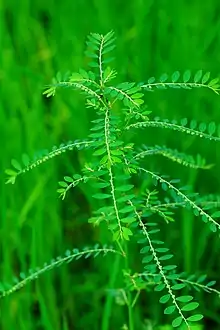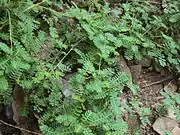Phyllanthus niruri
Phyllanthus niruri is a widespread tropical plant commonly found in coastal areas, known by the common names gale of the wind, stonebreaker or seed-under-leaf. It is a relative of the spurges, belonging to the genus Phyllanthus of the family Phyllanthaceae.
| Chanca piedra | |
|---|---|
 | |
| Scientific classification | |
| Kingdom: | Plantae |
| Clade: | Tracheophytes |
| Clade: | Angiosperms |
| Clade: | Eudicots |
| Clade: | Rosids |
| Order: | Malpighiales |
| Family: | Phyllanthaceae |
| Genus: | Phyllanthus |
| Species: | P. niruri |
| Binomial name | |
| Phyllanthus niruri | |
| Synonyms[1] | |
| |
Description

It grows 50–70 cm (20–28 in) tall and bears ascending herbaceous branches. The bark is smooth and light green. It bears numerous pale green flowers which are often flushed with red. The fruits are tiny, smooth capsules containing seeds.
Traditional medicine
Phyllanthus niruri has been used in traditional medicine for various illnesses,[2] like jaundice, chronic dysentery, dyspepsia, cough, indigestion, diabetes, urinary tract diseases, skin diseases, ulcer, sores and swelling.[3]
Phytochemicals
Lignans, flavonoids, triterpenes, sterols, alkaloids, and essential oils are found in this plant.[2]
Research
A 2011 Cochrane review found that there is "no convincing evidence that phyllanthus, compared with placebo, benefits patients with chronic HBV (hepatitis B virus) infection."[4]
Gallery
 Niruri fruit
Niruri fruit Niruri proliferation
Niruri proliferation
References
- "The Plant List: A Working List of All Plant Species". Retrieved June 6, 2014.
- Patel, Jay Ram; Tripathi, Priyanka; Sharma, Vikas; Chauhan, Nagendra Singh; Dixit, Vinod Kumar (2011). "Phyllanthus amarus: Ethnomedicinal uses, phytochemistry and pharmacology: A review". Journal of Ethnopharmacology. 138 (2): 286–313. doi:10.1016/j.jep.2011.09.040. PMID 21982793.
- "Plant Details for a Phyllanthus niruri SENSU HOOK.F.Non Linn". ENVIS Centre on Medicinal Plants. FRLHT. Retrieved 4 August 2020.
- Xia, Y; Luo, H; Liu, JP; Gluud, C (13 April 2011). "Phyllanthus species for chronic hepatitis B virus infection". The Cochrane Database of Systematic Reviews (4): CD008960. doi:10.1002/14651858.CD008960.pub2. PMID 21491412.
External links
| Wikimedia Commons has media related to Phyllanthus niruri. |
| Wikispecies has information related to Phyllanthus niruri. |